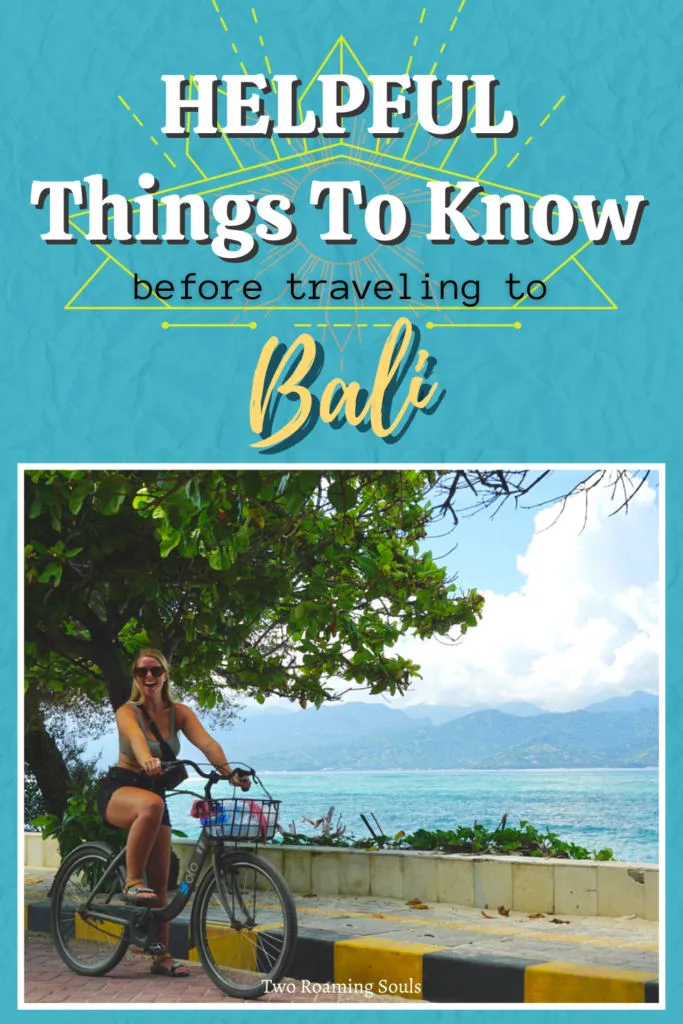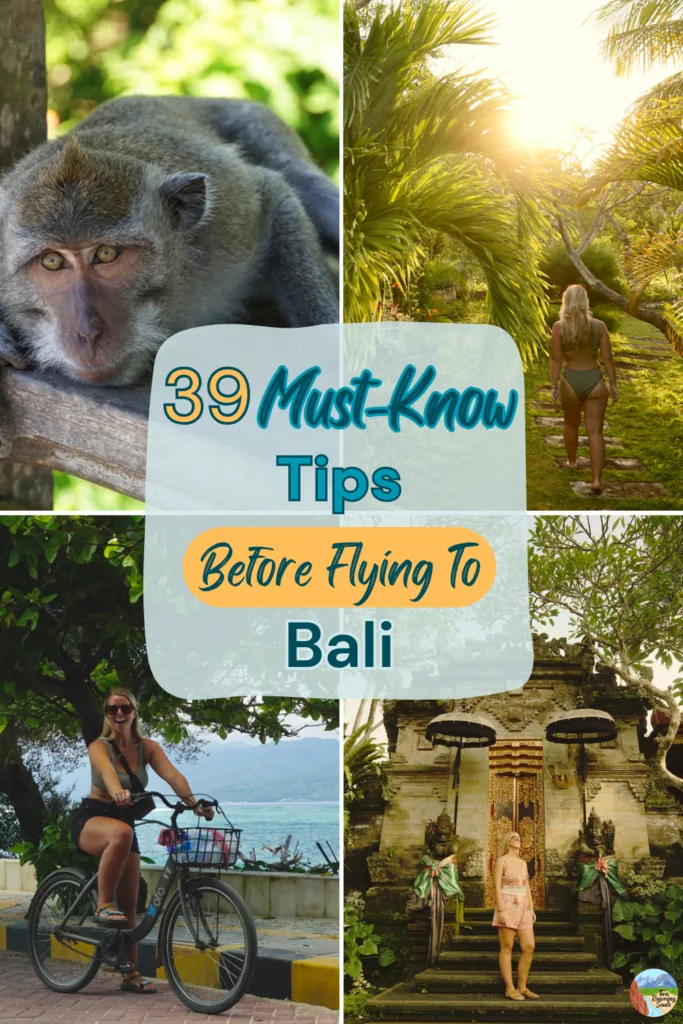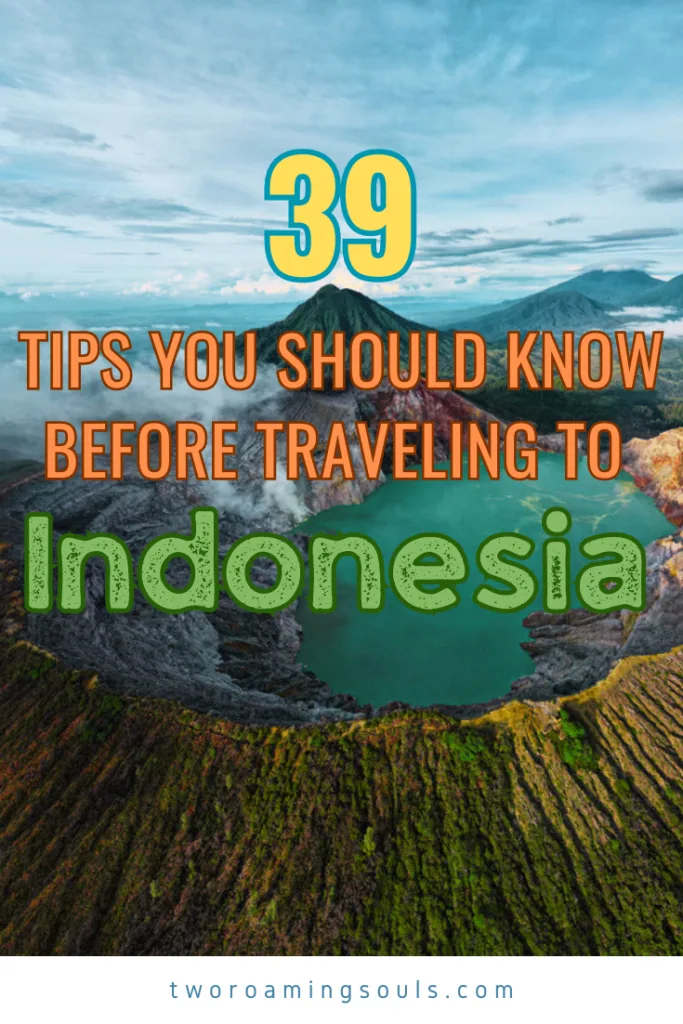Thinking of jetting off to Bali of one of the other Indonesian Islands? Then, get ready for an adventure like no other! But there are certainly some important things to know before visiting Bali and the surrounding Indonesian Islands.
First off, Indonesia is made up of 18,110 islands and islet. And 6,000 of which are habitable. And within this large swath of islands, Indonesia has so many amazing places to explore.
Without hesitation, Bali, Indonesia is one of the most sought-after destinations in Southeast Asia, and for good reason. Bali is known as the ‘Island of Gods’, with so much natural beauty that certainly feels like divine creation.
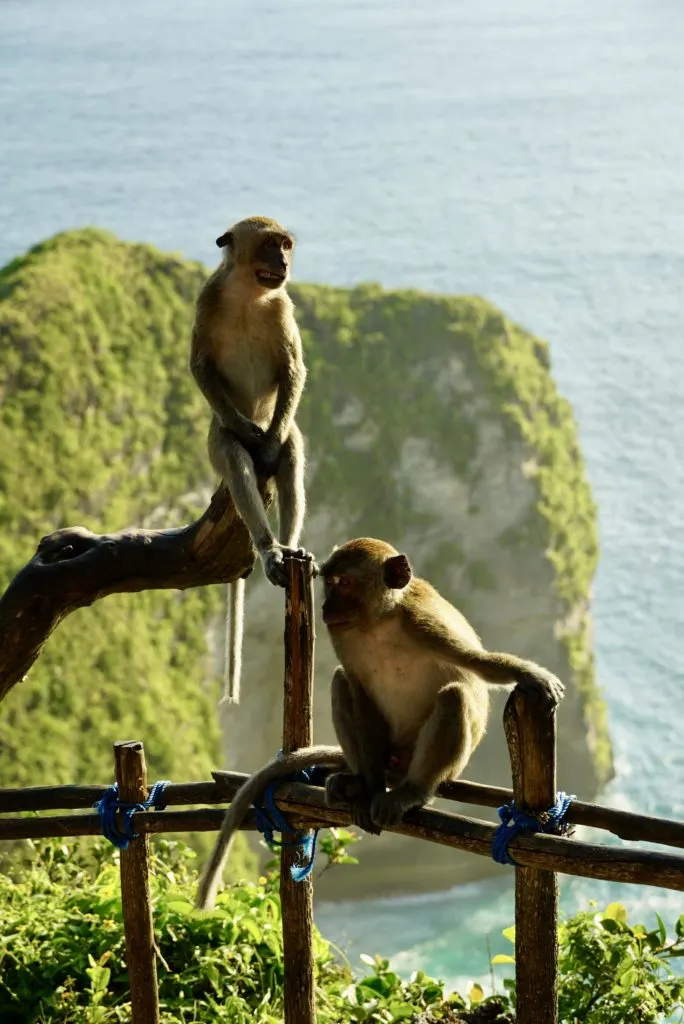
Bali has stunning beaches, endless waterfalls, ancient temples, and a whole lot of culture to soak in. But hold on a sec – before you pack your bags, we want to fill you in on some helpful Bali Travel Tips.
Whether you’re a newbie traveler or a total pro, this blog’s here to spill the beans on everything you need to have a blast in Bali. We’re talking about how to be respectful, where to munch on the best food, when’s the best time to go, and even some secret spots you won’t wanna miss.
We’re about to give you the lowdown on how to make your Bali trip a total dream come true!
This post may contain affiliate links. Disclosure policy.
Getting A Visa For Indonesia
One of the most important things to know before visiting Bali is how to obtain a visa.
All non-Indonesian residents will need a visa to enter into the country of Indonesia. There are two different ways you can obtain a Visa. One option is stopping at the On Arrival Counter and another option is to apply online before traveling to the country.
A tourist visa is only granted for 30 days in the country.
The cost for an Indonesian Tourist visa is 500,000Rp ($35 USD).
Indonesian On Arrival Counter
Getting a Visa On Arrival is pretty easy. There is a counter you can walk up to where you will show your Passport and pay the fee for the Visa. You will then proceed to Customs where you will get your stamp. There was no physical Visa handed to us.
From my understanding, the Bali On-Arrival Counter accepts credit/debit cards, and there is an ATM to take out cash. With that being said, I’d still have cash just in case.
IMPORTANT Note About Entering at the East Java – Juanda Airport: You will need CASH to obtain a Visa at the On Arrival Counter. They DO NOT accept credit cards or Debit Cards, and there is no ATM in this area (as of March 2023). We luckily had a little spare USD to cover the cost of the Visa. But be sure to plan ahead!
Applying For An Indonesian E-Visa
There is also the option to apply for a Visa online before traveling.
If traveling from the United States, you can apply here. Simply choose the state you live in, whether you are traveling for a single trip or multiple, and enter a security question. You will then get a registration number and be asked for your passport information, reason and dates for traveling, etc. You can also apply for an Indonesian Visa Here.
Make sure you apply in advance, it may take up to 3+ business days for your Visa to be approved.
Also, be sure to PRINT your visa before traveling or have the document readily available on your mobile phone. They will ask for it at the customs desk upon arrival. We suggest also having an extra copy just in case.
Extending A Visa In Indonesia
Upon arrival, tourists are allowed to stay for 30 days in the country. Visas can easily be extended to 60 days.
You should request an extension for your visa a minimum of 7 business days before its expiration date. If you applied for a visa online, you can extend your visa using your login information. If you got a visa in person, you may need to reach out to the embassy.
Extensions can go longer than 60 days but will require extra work. Typically, tourists can stay no longer than 180 days in a consecutive year. Speak to the embassy for more details on a longer tourist visa.
Also, make sure your passport won’t expire within 6 months from your departure date.
Exchange Cash Before Traveling to Indonesia

One thing I wish I had done before visiting Bali was exchange some cash. It’s best to exchange cash with your local bank before traveling to Indonesia. While there are ATMs at the airports, they will often have a bad exchange rate. And the ATMs in Indonesia have a cap on how much you can take out at one time.
The local currency is called Indonesian Rupiah (often abbreviated to IDR or Rp). One U.S. Dollar is equivalent to around IDR 15,481 Rp (as of September 2023).
Depending on the ATM, tourists are only allowed to get up to 2,000,000 Rp ($130 USD) out at one time. Some ATMs even had a cap of 1,000,000 Rp ($64 USD). Plus you are charged a foreign transaction fee every time you take out money.
You might get lucky with some ATMs allowing larger withdrawals in bigger cities, but it is not common.
Toward the beginning of our trip, we had to travel to an ATM nearly every other day. Especially when paying for tours that only accept cash.
“Choose Local Currency” When Taking Money Out Of An ATM
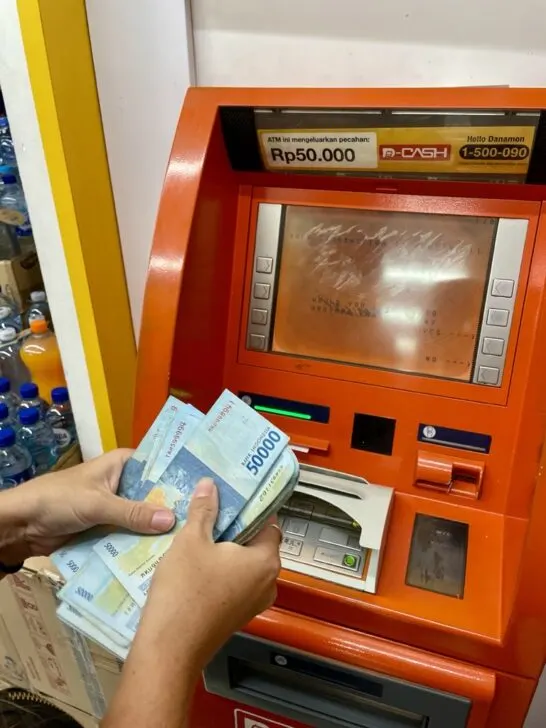
Oftentimes, when taking money out of an ATM or when paying with a credit card at local restaurants, you will get the question, charge in local currency or home currency (in my case USD). Always choose local currency.
By selecting the local currency, you delegate your home bank to decipher the exchange rate. Assuming you trust your bank, they will likely just match the current exchange rate. But if you select home currency, then the ATM or foreign bank might give a less favorable exchange rate and charge you a higher exchange rate.
Find A Bank With No Foreign Transaction Fees
For frequent travelers or those planning to use credit or debit cards extensively while abroad, having a bank that doesn’t impose foreign transaction fees can be a valuable asset. Alternatively, having a bank that reimburses you for foreign transaction fees can also be advantageous.
Here, is a compiled list of 15 excellent checking accounts that either waive foreign transaction fees entirely or offer significant reductions. Additionally, here are 9 top-tier credit cards that don’t impose foreign transaction fees, making them ideal choices for international travel.
You Don’t Need To Know Indonesian When Traveling To Bali, But It Can Be Good To Know Some Phrases
You should know that the national language of Indonesia is Bahasa Indonesia. But Bali has it’s own language too, Balinese.
You are better off learning Bahasa Indonesia because every Indonesian knows how to speak it. You can also learn Balinese, but just remember that Indonesians living on other islands may not understand Balinese.
You really don’t have to know how to speak much Indonesian when traveling to Bali. English is widely spoken in Indonesia. Especially in popular cities or tourist areas. But knowing a few Indonesian phrases can certainly help.
Plus whenever we did say a phrase it almost always put a smile on an Indonesian’s face. They enjoyed a tourist taking the time to learn a little bit about their culture.
Here are a few helpful Bahasa Indonesia phrases:
- Hello – Halo
- Thank You – Terima kasih (pronounced: teree mock ah see)
- You’re welcome – sama-sama
- Excuse me – permisi (pronounced: Perm me see)
- Toilet – Toilet
- Water – Air (but you can basically always just ask for water)
Indonesian Numbers:
- 1 – satu
- 2 – dua
- 3 – tiga
- 4 – empat
- 5 – lima
Download Google Translate for Offline Use
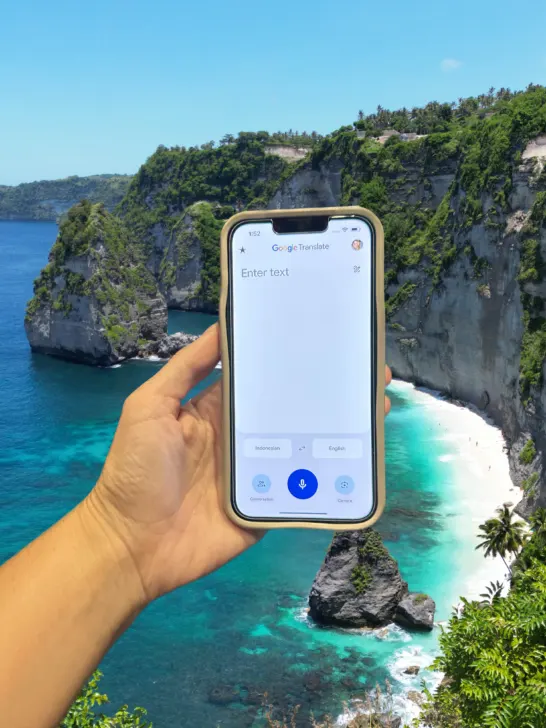
Downloading the Indonesian language on Google Translate for offline use before your trip can prove incredibly beneficial.
During international travel, there could be delays in getting your phone plan operational, or you may require an e-SIM. In such instances, having a means of communication with Indonesian speakers can be useful.
But I should note English is widely spoken in Indonesia. Especially in popular cities or tourist areas.
But it can also be helpful to communicate those harder phrases via Google Translate. So we used Google Translate multiple times a day with our hotel staff, restaurant servers, taxi drivers, etc.
You can also save certain phrases. For example, I am allergic to eggs, therefore, I needed to repeat this phrase at every restaurant we visited.
Best Time to Visit Indonesia
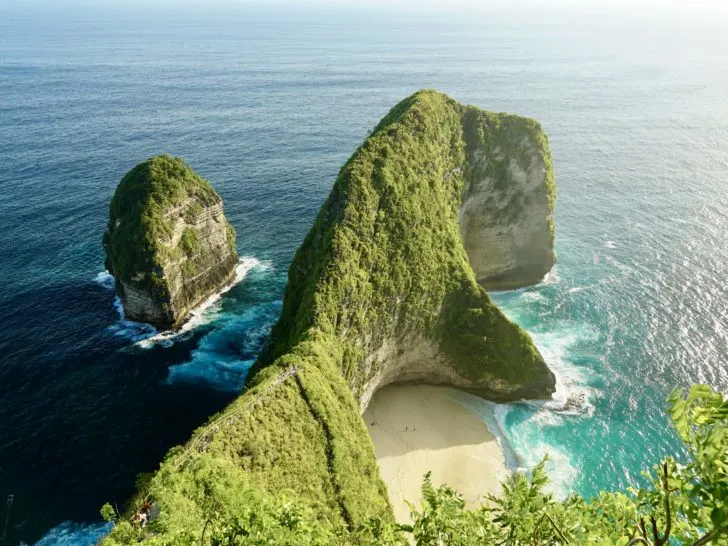
Indonesia is made up of 18,110 islands, so it covers a rather large area. But, generally, the weather in Indonesia is tropical, so you can visit the country year-round and expect warm-hot temperatures.
The temperature fluctuates very little throughout the year, and daylight hours also remain relatively constant.
The exception to tropical weather would be traveling to mountainous regions with higher elevations.
The primary variability of Indonesia’s climate is rainfall. Typically, Indonesia’s dry season is from April – October, and the wet season is from November – March. During the wet season, you are still likely to get some great sunny weather mixed in. (Jake and I visited in March and rarely had to deal with rain).
The off-peak months in Indonesia are typically October, November, February, and March. Which ultimately means fewer crowds and cheaper prices.
Where Should You Visit In Indonesia
Indonesia has TONS of amazing destinations to visit.
But Bali is the most popular destination. And even within Bali, there are many different places worth visiting.
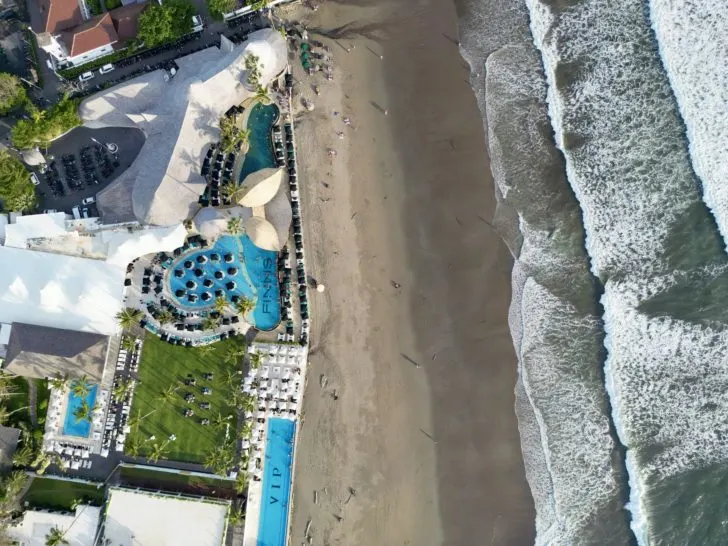
Some of our favorite places we visited in Indonesia were:
- Canggu:
- A popular hub for Digital Nomads, very westernized, lots of shopping, great restaurants, known for big beach clubs, Negatives: almost seemed like more tourists than local Balinese people. And the roads are not designed to handle the volume of visitors.
- Uluwatu:
- Small towns set up on a cliff-lined peninsula, less busy, has great surfing, little rainfall, easier/safer to get around on a motorbike because traffic is less congested.
- Nusa Penida:
- A beautiful island southeast of Bali. Kelingking Beach is simply one of the most breathtaking beaches you will ever witness, closely followed by Diamond Beach. But there were also other remote beaches to visit with fewer tourists, such as Suwehan Beach. Less developed and requires a ferry/boat ride from Bali.
- Gili Islands (Gili Trawangan):
- No cars are allowed on the island, only horse carriages and bikes are allowed. World-class snorkeling and scuba diving, crystal clear water. We simply loved the beach vibes here. There is the ability to party or relax depending on your mood.
- Ubud:
- An inland city surrounded by rice paddies and jungle. Endless waterfalls to explore (like honestly you get waterfall fatigue here!) Great spot for adventure seekers! Excellent restaurants and shopping. There is also the famous Tegallalang Rice Terraces located here. Negatives: no beaches, rain is more common.
- East Java:
- East Java is a completely different island from Bali, so a little harder to get to. But it’s home to Mount Bromo, Tumpak Sewu Waterfall, and Ijen Crater (which are simply some of the most breathtaking landscapes you will ever witness). You can find tours leaving from Bali that visit the best stops in East Java. If you have time we highly recommend taking the trip over there.
Obviously, the list of legendary places to visit in Indonesia does not stop here, but these were just some of our favorites while visiting this beautiful country.
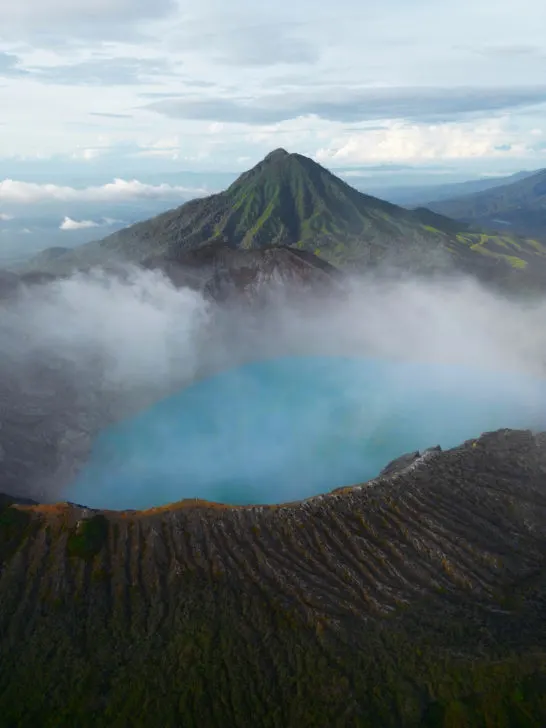
No Vaccines Required (But you might consider a few before traveling)
There is no requirement for certain vaccinations before traveling to Indonesia. But some common vaccines people get before traveling are Tetanus, Hepatitis A, and now Covid-19.
Some other vaccines that are optional are typhoid, cholera, yellow fever, Japanese encephalitis, rabies, etc.
Consult your doctor for the proper vaccines before traveling to Southeast Asia.
Don’t Drink The Tap Water
Many areas in Indonesia lack the proper infrastructure and water treatment facilities needed to provide safe and clean tap water. As a result, the water supply may be contaminated with pollutants, bacteria, and other harmful microorganisms.
Drinking untreated tap water in Indonesia can lead to waterborne diseases such as diarrhea, cholera, and typhoid fever, which can pose serious health risks to travelers and residents alike.
To stay safe and healthy, it’s recommended to drink bottled water or water that has been properly filtered and purified during your stay in Indonesia. This precaution helps reduce the risk of waterborne illnesses and ensures you have access to safe drinking water.
We often were served a glass of water at Indonesian Restaurants. While the water served is said to be “treated”, it still gave us concern. So we opted to just strictly drink bottled water. We heard mixed results from other travelers.
The best place we found to purchase bottled water is at convenience stores and markets. But it can also be found at gas stations, restaurants, and more. Many hotels will provide bottled water daily, but personally, we drink much more water (about 60oz daily) than was provided.
Is It Safe To Drink The Ice In Drinks?
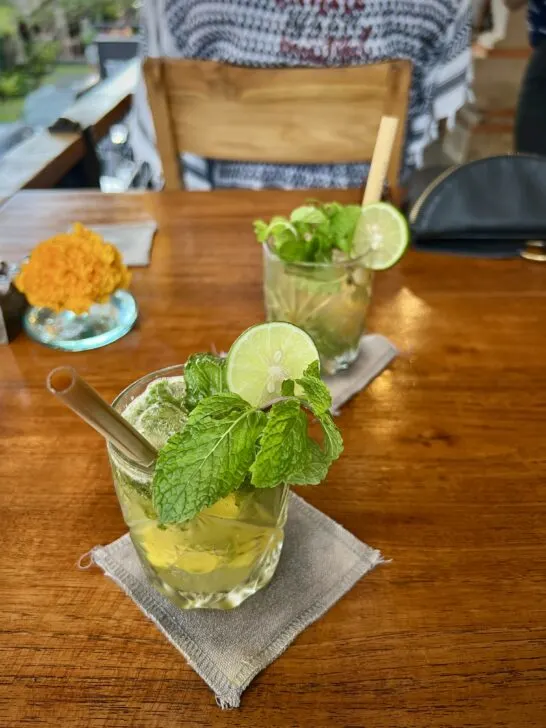
Restaurants typically procure their ice from external sources, ensuring that the ice used in beverages is manufactured in facilities with filtered water. To err on the side of caution, you can simply request your drink without ice.
Alternatively, you may opt for sealed bottled or canned beverages. This approach guarantees your peace of mind regarding the safety of the ice used in your drinks.
We drank many drinks with ice and did not encounter any major issues.
Can You Brush Your Teeth With The Tap Water in Bali?
It is generally not recommended to brush your teeth using tap water in Indonesia. The tap water in many parts of the country may not meet safe drinking standards and can contain contaminants and microorganisms that can be harmful if ingested, even in small amounts.
To be safe, it’s advisable to use bottled water or water that has been properly filtered and purified for brushing your teeth. This extra precaution helps reduce the risk of inadvertently ingesting unsafe water while maintaining good oral hygiene.
Preparing For “Bali Belly”
Unless you possess an exceptionally robust stomach, it’s likely that you’ll encounter a few stomach… episodes during your trip. These issues are commonly referred to as “Bali Belly” or “Traveler’s Diahrea”.
Even if you are very diligent about drinking bottled water, sometimes foods may be prepared or washed with tap water.
Considering the information provided earlier, it’s wise to have enough Tums and Imodium on hand before traveling. We discovered that locating these products in Bali can be a bit challenging, and they may have different names or be labeled in Indonesian.
Using an E-sim on Your Current Cellular Plan
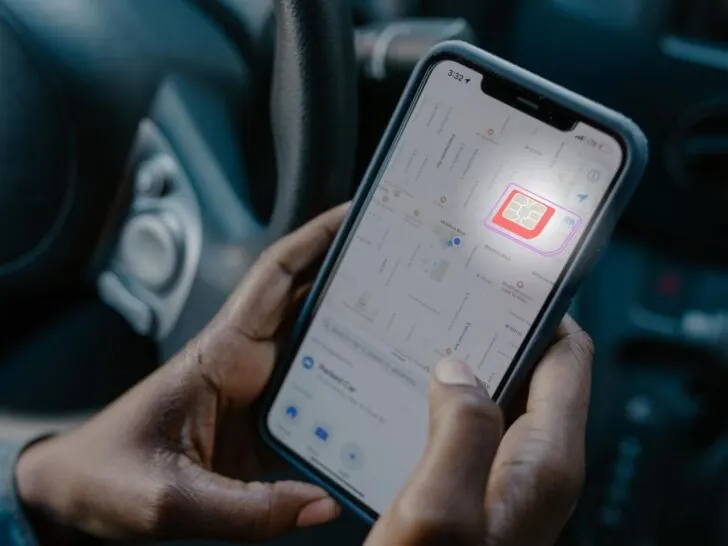
When traveling abroad to Bali, we were a little unclear on what phone plan we should choose. While our cellular provider is Verizon, their International Travel Plan seemed very costly, coming in at $100 per month or $10 per day.
Personally, we realized that making phone calls or sending text messages using cellular data wasn’t necessary for our needs. Our plan was to rely on Wi-Fi for communication with friends and family. However, we still required data for essential tasks such as ordering taxis and researching local destinations when Wi-Fi wasn’t readily available.
We opted for an E-sim which would allow us to retain our current phone plan while accessing data through a local cell tower. We highly recommend using E-SIM if you can. Here’s how to use an E-SIM for travel.
With E-SIM you have the flexibility to choose the specific country you’re visiting or opt for a broader region like Asia/Pacific.
We personally used Maya e-sim which worked splendidly. You can either choose the local country you are traveling to or choose a general region (such as Asia/Pacific).
You can purchase anywhere from 1GB, 3GB, 5GB, 10GB, or unlimited data in a 30-day pass. You can easily add this travel e-sim to your phone and use this as your data when not using wifi.
There is wifi in most hotels, restaurants, shops, etc (more info below).
Getting A Physical SIM Card For Your Cell Phone
There is also the option to add a physical sim to your current phone. But this would require your phone to have a way to remove the current SIM inside the phone. (Our iPhones from Verizon did not have this capability).
You can often pick up a physical SIM card from a kiosk in the airport, from convenience stores, or local vendors around town.
There is also the option to buy a pre-paid SIM online before you travel.
Wifi is Everywhere (but it kinda sucks!)
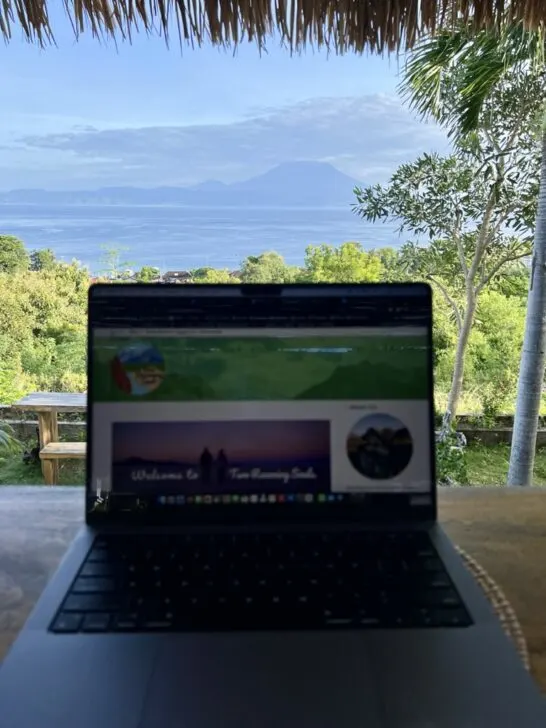
Fortunately, Wi-Fi is readily available in most public spaces. But I wouldn’t expect high-speed internet in most places. This can especially be helpful if you opt out of getting a local data plan where you rely on wifi connections to get around the city.
While there were rumors about fast internet in Southeast Asia, our personal experience didn’t align with these expectations. In most cases, the internet in our hotels was slow but still serviceable. However, maintaining a consistent and reliable connection proved challenging on numerous occasions during our journey.
If this is important to you, I would suggest filtering reviews for ‘Wifi’ before booking a place.
Download the Ride-Sharing Apps
Grab and Go-Jek are Indonesia’s taxi apps similar to Uber or Lyft in America.
Through the app, you have the option to arrange rides or have food deliveries right to your doorstep. What sets it apart is its budget-friendly pricing, often more affordable than traditional taxi services.

In fact, we were pleasantly surprised to discover that we could have meals delivered for less than $10, covering all expenses including tax, delivery fees, and gratuity.
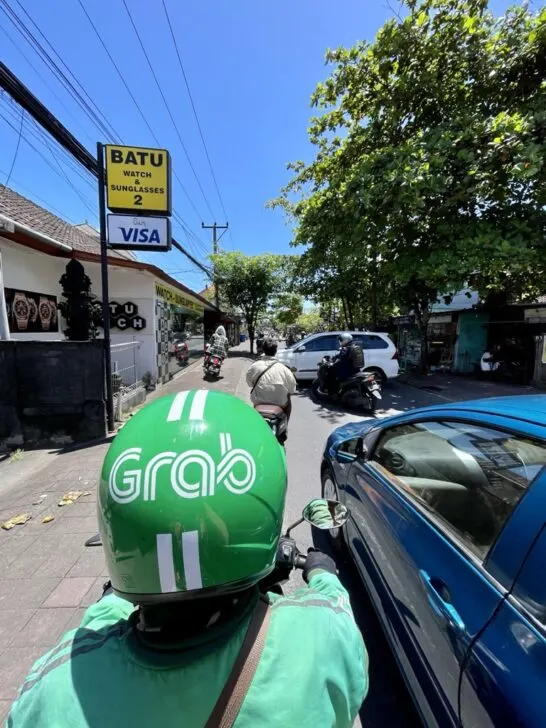
It’s also very common to hop on the back of a motorbike in Bali. And in some areas, motorbikes can get you to your destination much faster than a car. However, motorbikes are less safe than cars, so factor that added risk into your decision.
Grab & Go Jek Versus Taxi
There are safety considerations that make opting for Grab a preferable choice over traditional taxis. This is primarily because all Grab drivers undergo comprehensive background and driving history checks. Additionally, when you book a Grab ride, your phone’s GPS actively tracks your location.
Given potential language barriers, it proved quite convenient to simply input your destination address and have confidence that you would reach your intended location safely.
Additionally, Grab rides were almost consistently more cost-effective than taking a traditional taxi. The only minor drawback was occasionally having to wait a few minutes for your ride to arrive, in contrast to taxis, where drivers are typically readily available for immediate service.
However, there are many places where local taxi companies are fighting back against Grab & Go-Jek. They insist that ride-share companies are offering artificially low prices (backed by investor money) to drive out the competition. A battle we have seen play out in many places in the world.
In certain places in Bali, you may see signs ‘prohibiting’ them and insisting that visitors pay a local taxi driver.
I’m pretty sure these bans are not enforceable by law. But taxi drivers and companies have taken it onto themselves to harass ride-share drivers entering their ‘turf’.
You Need A Travel Adapter
An important thing to know before visiting Bali is that their electrical outlets require a travel adapter (for US visitors).
Indonesia uses Type C and F power outlets. The standard electrical voltage is 230 V, with a frequency of 50 Hz.
In the United States we primarily use Plug Type A and Type B. Type A is the 2 prong plug and Type B is the 3 prong plug.
Unlike Vietnam and Thailand where many of the hotels, trains, etc had various different plug types, there was only Type C and F in many of the places we stayed in Indonesia.
Which Travel Adapter is Best?
Travel adapters are available in various configurations, but our preferred choice is this particular travel adapter. It offers a well-balanced combination of USB-C and USB-A ports, including one USB-C port capable of delivering 35 Watts of power.
For those in need of a high-powered charger suitable for charging laptops, the more expensive Epicka Travel Adapter is a great option, offering a remarkable 75-watt output USB-C port. This is sufficient to charge even a larger MacBook Pro, eliminating the need to carry the bulky Apple charger brick.
If you’re seeking a cost-effective travel adapter with multiple ports for smaller devices, this option provides excellent value.
Lastly, here’s a travel adapter featuring predominantly USB-A ports, although it’s worth noting that USB-A ports are gradually becoming less common.
Consider Having A Voltage Converter
In addition to travel adapters, you might consider bringing a voltage converter. In the U.S. the supply voltage is 120V. In Bali, the supply voltage is 230V.
Most electronic devices indicate their acceptable voltage range on the power supply. Prior to packing any electronic items, carefully inspect the fine print on the power cord or adapter, as this information usually specifies the range of voltages they can handle.
For instance, my Apple MacBook charger explicitly states its support for a voltage range of 100-240V, making it adaptable for use both in the U.S. and Indonesia without the need for a voltage converter.
Devices that generate heat, such as hair straighteners, irons, and electric kettles, should be your primary concern.
It’s worth noting that minor voltage differences, like 110 volts and 120 volts or 220 volts and 230 volts, are often interchangeable without issues.
In our experience, the majority of our electronic devices, including cell phones, computers, cameras, and headphones, were compatible with a 230V power supply.
However, my Braun Electric Toothbrush Charger was designed for use within the 110-130V range. Therefore, connecting it to an Indonesian outlet posed a significant risk of damage, rendering it unusable. In this case, we would either need a voltage converter or consider getting a 230-volt version of the toothbrush charger (which proved to be a more cost-effective and practical solution).
Ultimately, it’s advisable to confirm the compatibility of all your chargers with a 230-volt power supply before your trip. If not, having a voltage converter on hand may be essential to ensure your devices receive adequate power and remain safeguarded against potential damage.
From our perspective, it is generally more convenient to explore alternatives for items that require voltage converters.
But if you decide you need one, this is a good value voltage converter option.
Bathrooms in Bali – Bring TP (remote places don’t have any)
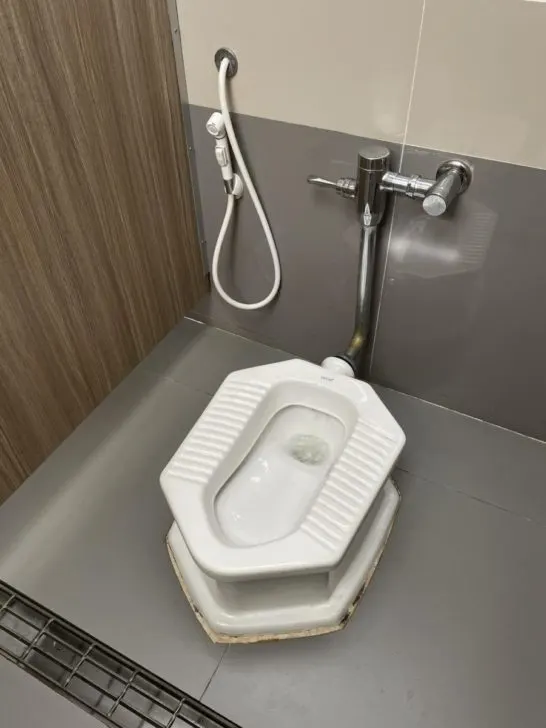
Toilets in Southeast Asia can be quite different from what we’re used to in the U.S. While many hotels have regular toilets, you might encounter something called a “squatty potty” instead. And instead of toilet paper, there’s often a spray hose.
I always carried a small bag of toilet paper with me when using public restrooms. Trust me, it comes in handy!
To be honest, Jake and I didn’t really get the spray hose thing, but it’s a common practice in Southeast Asia. It’s like their version of a bidet. I personally didn’t like the idea that everyone touched it after using the toilet, and it’s placed close to private areas before being put back on the wall. But different cultures have their own ways!
One more thing to know before visiting Bali is you can’t flush toilet paper down the toilet like we do in the U.S. You have to put all paper products, including toilet paper for #2, in a trash can.
Westernized Food In Bali
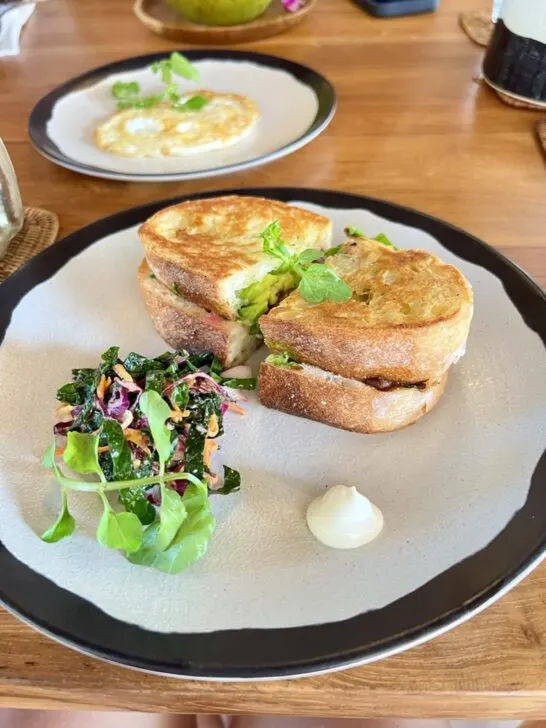
If you think about Indonesian food, what comes to mind? United States Citizens are probably very familiar with Chinese, Thai, and Vietnamese food, but Indonesia doesn’t exactly have a popular exported cuisine to the United States.
And that is basically because they really only make basic cuisines like fried rice (aka nasi goreng), or replicas of food from other countries such as Chicken Satay or Curries.
Therefore, many of their restaurants almost have a different country influence. So if you are looking for some decent Westernized food, some places may just surprise you.
Bali is undeniably the top tourist destination in Indonesia, drawing visitors from all over the world. One of its standout features is the abundance of excellent restaurants serving delicious Western cuisine.
During our travels in Vietnam and Thailand, we made attempts to savor Western dishes, but unfortunately, many fell short of our expectations. However, in Bali, we discovered that they excel at replicating Western dishes quite accurately and with good flavor.
Food Comes Out When Ready
Dishes are served as soon as they are ready, which can result in one person finishing their meal before the second person even receives theirs. However, this approach ensures that the food arrives fresh and hot. Even if you’ve ordered an appetizer, it might occasionally come after the main courses.
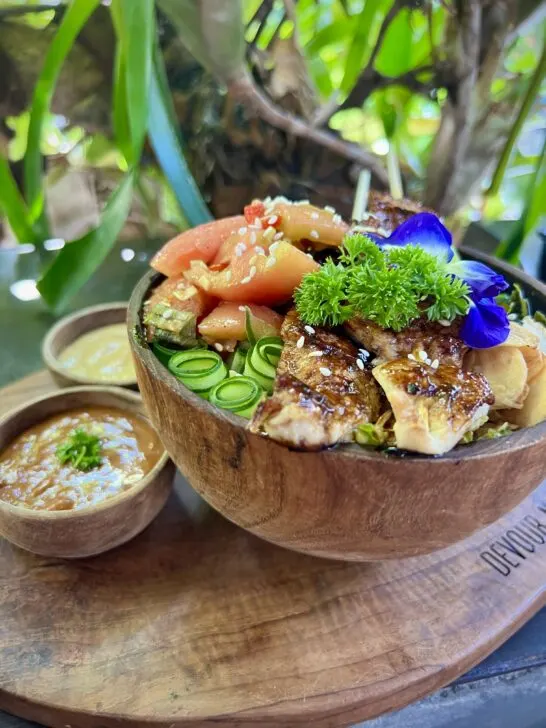
And not all restaurants adhere strictly to the traditional Westernized order of service (i.e. drinks, appetizers, entrees).
While there’s not much you can do to change these practices, one workaround is to order your appetizer in its entirety before mentioning your entrees.
The same applies to cocktails. You can essentially manage the pacing of your meal at the restaurant, provided you don’t mind flagging down the server multiple times during your dining experience.
Service in Indonesia was more similar to the U.S. with waiters being readily available to help and assist when you needed something.
No Tipping Required
One of the delightful aspects of dining out in Bali is that tipping is not considered customary. While gratuities are always appreciated, they are viewed as an extra gesture of goodwill for the server, unlike in the U.S., where tips are a significant part of their income.
We’ve observed that tipping is gradually becoming more prevalent in certain Southeast Asian countries. So, even though it’s not an established practice, servers or taxi drivers might perceive you as a foreigner and anticipate a small additional tip.
Ultimately, it comes down to your discretion. If someone assists you or provides outstanding service, why not brighten their day by offering a little extra appreciation in the form of a tip!
Hotel Pictures On Booking Websites Can Be Misleading
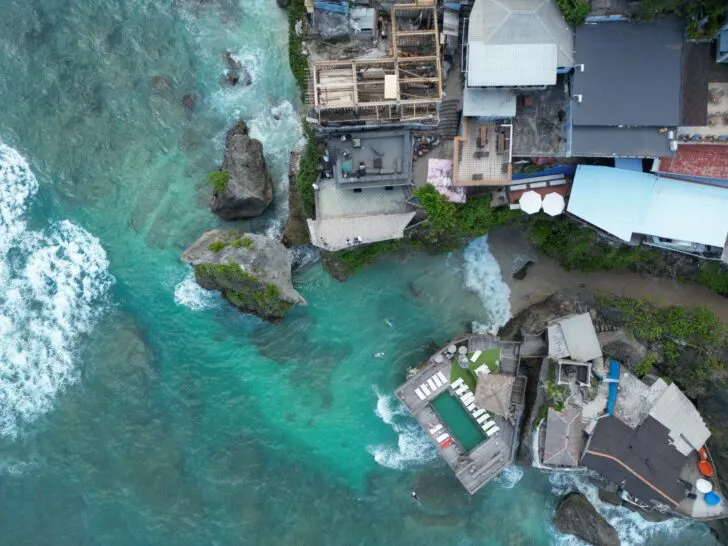
Sometimes the hotel images displayed on platforms like Booking.com, Expedia, Agoda, and similar sites portray the accommodations as exceptionally luxurious. However, these photos are frequently taken when the hotel was brand new and in impeccable condition. We noticed that many of these images tend to present the hotels as significantly more upscale than they actually appeared in person.
To be fair, the hotels were not terrible by any means, but we often encountered issues like bathroom mold, wall scratches, torn wallpaper, and occasionally, air conditioners that were long overdue for cleaning.
Our top recommendation is to peruse recent reviews to gain a more accurate understanding of what you can expect. People are generally candid about their experiences and are not hesitant to leave negative reviews if their stay was less than satisfactory.
It’s important to note that our choices predominantly leaned towards budget-friendly options, prioritizing affordability while ensuring positive reviews. Keep in mind that this perspective may differ if you decide to go for more upscale accommodations.
Our most valuable piece of advice remains reading recent reviews diligently to obtain an accurate depiction of what you can expect. Travelers often provide honest feedback to assist fellow adventurers. It’s worth mentioning that booking websites typically showcase the highest ratings, which might be from years ago, so remember to use filters to access recent reviews.
Furthermore, it’s essential to consider the impact of COVID-19, which has influenced hotel renovations and maintenance schedules. Be prudent in your assessments, especially when certain establishments may require refurbishment and upkeep due to pandemic-related constraints.
Be Careful With Your Luggage Weight (Pack Less!)
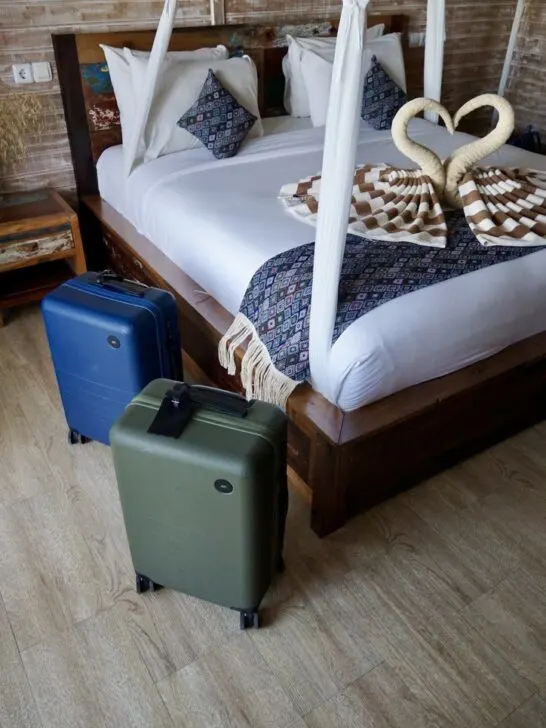
You might need to be more conscious of your luggage weight when traveling in Southeast Asia. We often opted to carry on our luggage rather than check a bag because we liked knowing our stuff is going to successfully make it to the next destination with us.
But we found ourselves in trouble a couple of times with the weight of our carry-on suitcases. We travel with the Monos Carry-on Plus. This allowed us to travel full-time in different climates for 3 months.
But this often surpassed the size requirement and weight capacity a traveler is allowed on many of the Airlines in Southeast Asia. We had to either check our bags (even though they can fit in the overhead bin) or a couple of times, slyly hide the bag as we were checking in.
The weight limit for some Indonesian budget airlines is as low as 15lbs (7kg). This is often the combined weight they allow for both your carry-on and personal item. Which in my mind is nearly impossible, especially if you are accustomed to domestic US flights.
Anyways, just expect to have to check your carry-on or try to keep the weight as minimal as possible.
Add An Air Tag To Your Luggage
Pro-Tip: add an Apple AirTag to your carry-on. (That way if you have to check your carry-on, you can at least track it).
This also provides a sense of security when you leave your bag in your hotel room. Or when storing it for a couple hours when checking in or checking out.
We particularly appreciate the Monos bag because it comes with a locking feature. Which is useful in situations where there isn’t a safe provided in the room. With the locked suitcase, we felt confident that our valuables were generally secure, even when the hotel staff cleaned our room.
Lack Of Good Snacks!
One of the things I wish I had known before visiting Bali was the lack of good snacks.
We often struggled to find quality snacks when traveling around Indonesia. They have tons of unique options that we found sub-par.
It was almost easier to just go out to eat than to find tasty snacks. But sometimes when you are out on a hike or somewhere where restaurants aren’t abundant, you might want a snack instead to hold you over.
Anyway, just expect to not have your comfort snacks. And many of the provided snacks are pretty unhealthy, such as cookies, chips, candy bars, etc. The convenience stores and markets don’t have traditional snacks like granola bars, jerky, trail mix, etc.
Bring Ziplock Baggies
This was advice we got from another travel blogger before traveling to Southeast Asia. Zip Lock bags do not exist overseas or if they do, they certainly make them hard to find.
This can be nice for packing snacks, keeping valuables dry on a wet hike, or various other things. Any they take up no space, so pack a few in your suitcase.
Be Careful With Street Food
When enjoying street food in Indonesia, it’s essential to exercise caution. While street vendors offer a tantalizing array of local delicacies, hygiene standards can vary.
Be mindful of where and what you eat, opting for vendors with good sanitation practices and a steady stream of customers. Ensure that the food is thoroughly cooked and served piping hot. If the local food looks like it has been sitting around for a while, you might want to pass.
Additionally, avoid consuming unpeeled raw fruits and vegetables to minimize the risk of foodborne illnesses. By being selective and vigilant, you can savor the rich flavors of Indonesian street cuisine while staying healthy during your travels.
Note: Many bathrooms don’t have soap, sooooo, as you can imagine, many of the street vendors are probably not thoroughly washing their hands….
Get Travel Insurance Before Traveling to Bali
It’s important to note that your health insurance likely won’t provide coverage while traveling abroad. Therefore, it’s highly advisable to ensure you’re well-prepared with travel insurance.
We personally recommend SafetyWing for your travel insurance because it’s designed with digital nomads in mind. Their affordable plans offer global health coverage, trip interruption protection, and the flexibility to suit your ever-changing lifestyle. Knowing you’re covered no matter where you are lets you focus more on enjoying your travels and less on what-ifs.
Two other widely recognized travel insurance companies are World Nomads and Allianz. World Nomads tends to offer coverage for more adventurous activities like skydiving, trekking, or even unusual incidents like encounters with monkeys (though it’s crucial to thoroughly review the policy details). This comprehensive coverage, however, comes at a slightly higher cost.
On the other hand, Allianz, the travel insurance we personally chose, provides coverage for more typical travel-related issues, such as minor damages to a rental car or accidental injuries during a city walking tour. Depending on the duration of your trip, you can opt for either an annual plan or a shorter-term one.
There are numerous other travel insurance companies available, so you have a variety of options to choose from to suit your specific travel needs.
Beware of Monkeys!

The monkeys have grown accustomed to daily visits from tourists and are not afraid to get close. Despite their adorable appearance, it’s crucial to remember that they are still wild animals and may potentially carry rabies.
Monkeys may boldly snatch items like bags, sunglasses, water bottles, and more. Once they have their prize, retrieving it can be quite challenging, as they may respond by displaying their sharp teeth and making a quick getaway.
To mitigate such encounters, secure loose belongings and keep your bag within close reach. These monkeys can be remarkably cunning, so it’s essential to exercise caution. Don’t be afraid to scare them off if they get too close for comfort.
You Might Want To Think Twice About Renting A Motorbike In The Big Cities
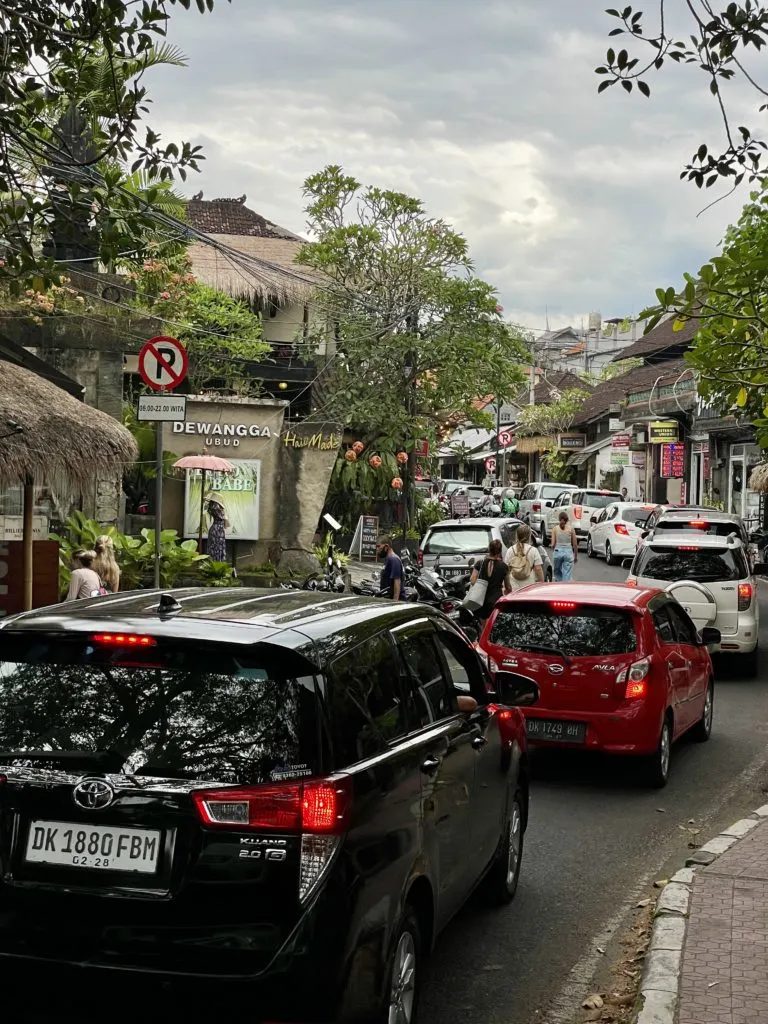
The driving and traffic in Southeast Asia was a huge culture shock. In populated areas, it felt like the roads were always full of cars and motorbikes.
While traffic laws exist, enforcement can be inconsistent, leading to a lack of accountability for reckless driving behavior.
It is common for tourists to rent motorbikes in Bali, but I would only choose this option if you have experience driving a motorbike and are familiar with driving in congested areas.
If you decide to rent a motorbike, make sure to prioritize safety by using a helmet, exercising common sense, and driving with utmost caution.
We felt more comfortable riding motorbikes in the less populated areas like Uluwatu, outside Ubud, and Nusa Penida. But busier places like Denpasar, Canggu, and Kuta are more intimidating to ride in.
It’s Cheap To Travel Domestically
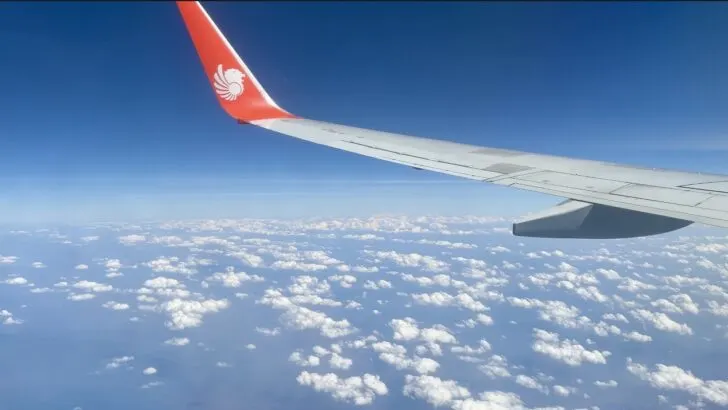
Traveling within the country is significantly more affordable than the international flights required to enter and exit the country. While it’s not quite as cheap as some other Southeast Asian Countries, it can still be an affordable way to get around to the different islands.
Ferries Are A Common Way Of Transportation
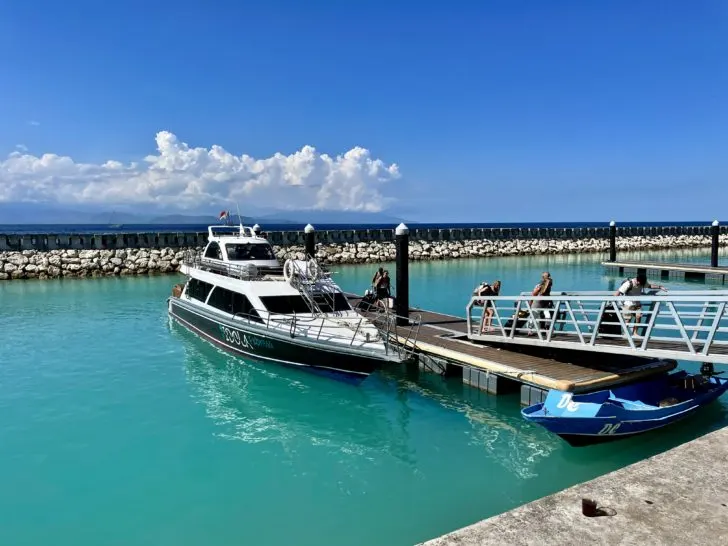
Like mentioned above, Indonesia is made up of many different islands. So there are many ferry systems in take to get you from one island to the next.
Additionally, some companies will set up a bus or taxi to assist you in getting from your hotel to the ferry port. To find cost-effective transportation options within Indonesia, we relied on the 12goAsia website.
I will admit that boat transportation can range from pleasant and scenic to uncomfortable and downright terrifying.
In rough seas, an easy boat ride can become turn into an uncomfortable experience.
A few of the most popular places to visit via boat are Nusa Penida, Nusa Lembongan, and the Gili Islands (Gili Trawangan, Gili Meno, and Gili Air).
Grocery Shopping Is Way Different In Bali
Unlike the United States, where large department stores offer a wide range of products all under one roof, Bali doesn’t really have a similar setup. In fact, the island lacks extensive grocery store chains as well.
While you can find some grocery stores in the major cities, reaching them may not always be straightforward, and these stores primarily cater to tourists rather than serving as the primary shopping destinations for locals.
If you’re in search of groceries, your best bet is to explore the local markets scattered throughout the town or look for small vendors who transport fresh produce on their motorbikes.
As for other everyday items like toiletries, you’ll likely need to stroll through the city and discover small, local convenience stores that offer these products.
Tampons Can Be Challenging To Find
One of the important things to know before visiting Bali for my female friends is that tampons are a little harder to find in Southeast Asia. You can likely find pads, but tampons are not very common.
I suggest trying to pack enough tampons for your extended travel or consider using a menstrual cup instead.
Sunscreen Is Different in Southeast Asia
The sunscreen in Southeast Asia is different from the brands we are used to in the U.S. We tried a couple of different brands and one was super thick and pasty (like seriously impossible to fully rub into your skin). And another one being what seemed “watered down”. After a full day in the sun, we would notice a splotchy tan/burn.
We suggest bringing as much sunscreen as you can if it fits into your suitcase. You might be able to find some Westernized sunscreens in the major cities, but they will likely cost a pretty penny. But honestly, it might be worth it!
Also, be sure to make sure the sunscreen you are buying or bringing is Reef-Safe.
Visiting During Nyepi Day

Nyepi Day is a popular celebration in Bali that can be super fun to partake in. It’s also known as the Day of Silence. It’s a significant and unique Hindu holiday and marks the beginning of the Balinese Saka New Year. It is a day of complete stillness and reflection.
Nyepi occurs in March after the new moon.
During Nyepi, the entire island comes to a standstill. There is no noise, no work, no travel, and even the airport is closed for 24 hours. People stay indoors, and no lights are allowed in the evening to avoid attracting evil spirits. It is a time for meditation, self-reflection, and spiritual cleansing. (Tourists must also stay indoors and are not allowed to roam the city, so it’s best to plan ahead).
The day before Nyepi, there are vibrant processions and ceremonies, including the famous Ogoh-Ogoh parade, where enormous paper-mâché statues symbolizing evil spirits are paraded through the streets and later burned. They take place all across Bali, in nearly every village.
Nyepi Day offers a unique opportunity for visitors to witness the deep spirituality and cultural richness of Bali, as well as to experience the rare tranquility that descends upon this bustling island during this remarkable day of silence.
How To Respectfully Visit Temples

It’s essential to be mindful of local customs and show the utmost respect for the cultural and religious significance of these sacred places. Dress modestly by wearing attire that covers your shoulders, chest, and knees, and consider bringing a sarong or long scarf to meet modesty standards if necessary.
It’s important to remove your shoes before entering the temple and follow any posted rules and guidelines. Inside the temple, maintain a quiet and peaceful demeanor, refraining from loud talking or disruptive behavior.
Avoid touching or disturbing religious artifacts, statues, or offerings, and never point your feet at sacred objects.
Lastly, be aware that customs and practices may vary among temples and regions in Indonesia, so it’s always a good idea to observe and adapt to the specific traditions of the place you’re visiting.
Related Posts To Things To Know Before Visiting Bali
Takeaway | Things To Know Before Visiting Bali
Indonesia is a captivating and diverse destination that promises unforgettable experiences for every traveler. It’s crucial to be well-prepared and aware of the unique aspects that make Indonesia such a distinct place to explore.
By understanding the essentials we’ve discussed in this guide, including cultural norms, travel safety, health precautions, and practical tips, you can enhance your adventure and make the most of your time in this breathtaking part of the world.
Save These ‘Bali Tips For First-Time Travelers’ For Later
